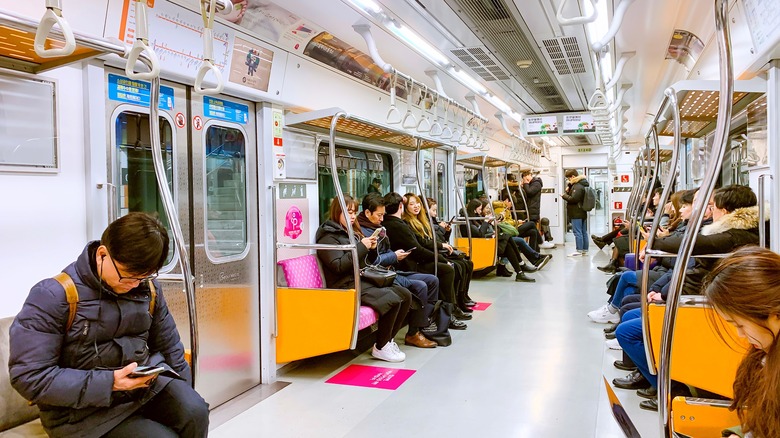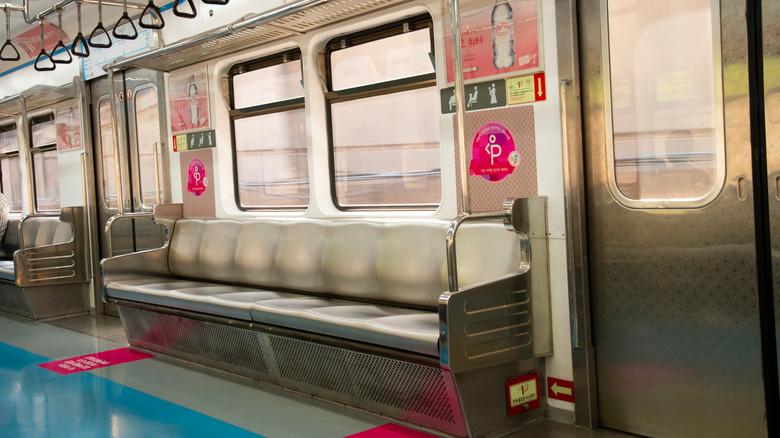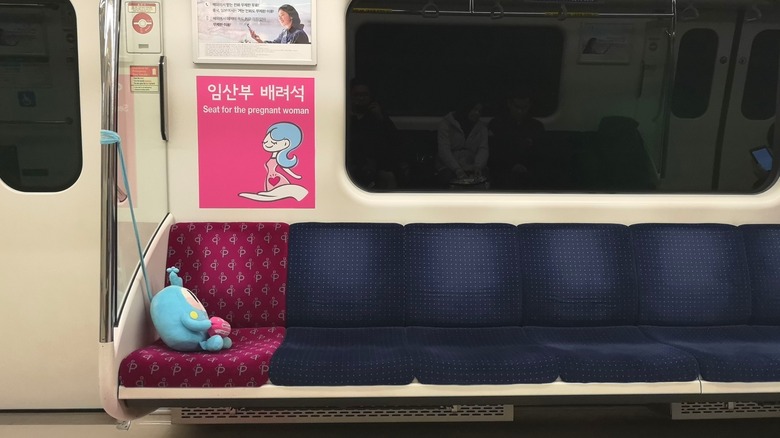What Tourists Need To Know About The Pink Seats On South Korean Subways
When traveling to East Asia, particularly to South Korea, one of the first things tourists will notice about the subway system is its immaculate efficiency and cleanliness. Seoul's system is considered among the best in the world — it handles 2.5 billion passengers annually across nine subway lines and 288 stations that cover nearly 200 miles. Its accessibility, connectivity, affordability, infrastructure, and long operating hours (5:30 AM to 1:00 AM) make it top-of-the-line. Plus, all signage is written in both Korean and English! However, there is one feature that stands out in its trains, especially for first-time visitors: the pink seats. Understanding the purpose of these seats is essential for respecting local customs and making the commuting experience more considerate and inclusive.
Priority seats make up 30% of all seating on South Korean subways. There are seats for people with disabilities, the elderly, children, medical patients, and people traveling with young children. The pink seats are designated exclusively for pregnant women. This initiative, part of the "Pink Light" campaign, was introduced to create a more comfortable and supportive environment for expectant mothers. Priority seats have been a part of the subway system in South Korea since 1985, but exclusive pink seats were only introduced in 2013 after many complaints from pregnant women who were harassed by elderly people for sitting in priority seats. These seats are open to all traveling pregnant women, from those in their ninth month to the early stages of their pregnancy, who may not look visibly pregnant.
Pink seats for pregnant women
The Seoul Metropolitan Government has invested 460 million won ($330,000) into the project to combat an emerging pecking order of 'who is most vulnerable' on the subway. This hierarchy, affected by traditional values toward the elderly, created an environment where pregnant women were not respected or given priority seating. An official from Seoul Metropolitan Rapid Transit explains, "There are many people who don't show the decency of yielding a seat to pregnant women, but hopefully, the campaign changes their minds" (via Korea Times).
The pink seats are easily identifiable by their color and accompanying signage that displays an image of a pregnant woman. These seats are usually located at the ends of subway cars, near the doors, making them more accessible. Signs, stickers, and LED lights indicate that these seats are reserved for pregnant women. Regular public service announcements on the trains also remind passengers of the purpose of these seats.
The "Pink Light" campaign integrates technology to even further assist pregnant women. Some trains have introduced a device embedded near the courtesy seat that emits a pink light signal when a pregnant woman carrying a special Bluetooth sensor boards the train. This signal alerts other passengers to offer their seats to the expectant mother, even if the pink seats are occupied — an innovative approach that ensures pregnant women receive the consideration they need without having to ask for it directly. Remarkably, the pink light stays on until the pregnant woman finds a seat.
Tips for using the subway in South Korea
The pink seats initiative sets a powerful example of how thoughtful design and public awareness can create a more accommodating environment for subway passengers. When using the subway, tourists should avoid sitting in these unless they are pregnant. Even if the subway car is crowded and the pink seats are empty, it's considered impolite to occupy them if you are not an expectant mother. If you accidentally sit in a pink seat, it's courteous to offer it to a pregnant woman if she boards the train. In any case, if you see a pregnant woman and no pink seats are available, if you are able to, it's kind to offer yours, regardless of where you are sitting.
Learning some basic Korean words and phrases, like how to ask if someone needs a seat (앉고 싶니 "anjgo sipni), "please take a seat" (자리에 앉으세요 "jalie anj-euseyo"), "thank you" (감사합니다 "gamsahabnida"), "please" (제발 "jebal"), and "you're welcome" (괜찮아요 "gwaenchanh-ayo"), can be helpful when it comes to communicating with locals who might not speak English. Moreover, if possible, plan your subway travel during off-peak hours to avoid crowded rush hour trains and ensure that designated seats are available for those who need them most. For tourists, understanding the purpose of the pink seats and respecting their intended use is a small act of respect that not only enhances the travel experience but also reflects the broader cultural values of consideration and inclusivity in South Korea.


